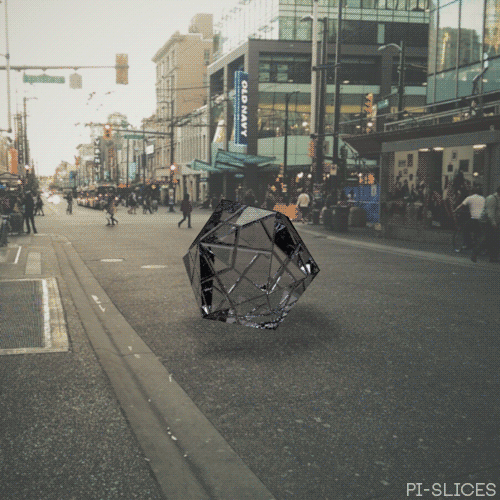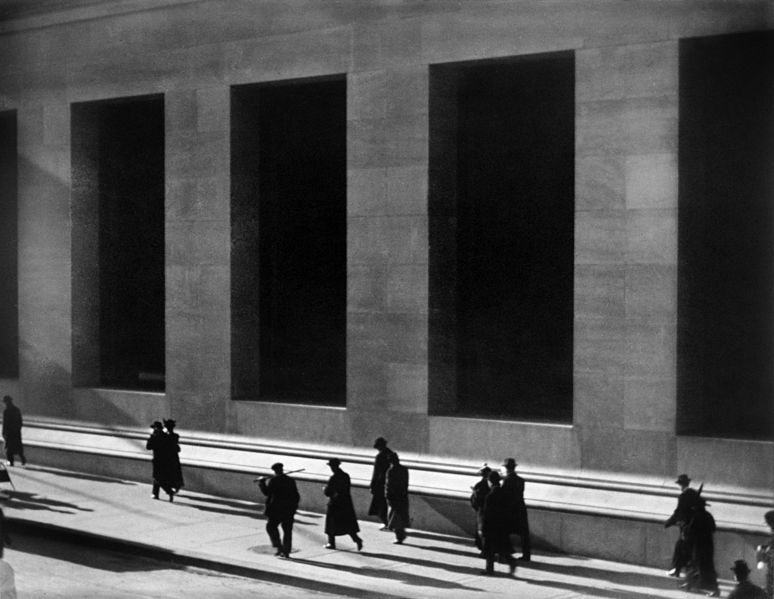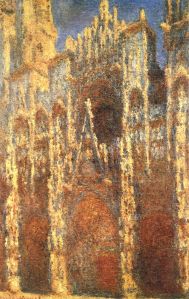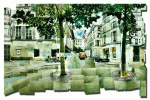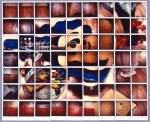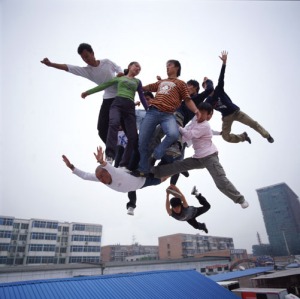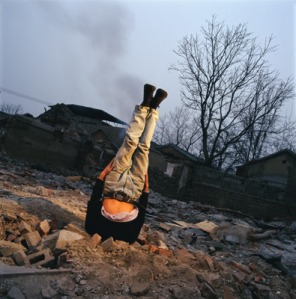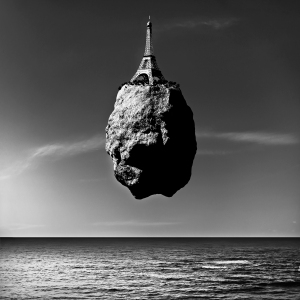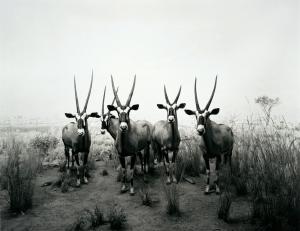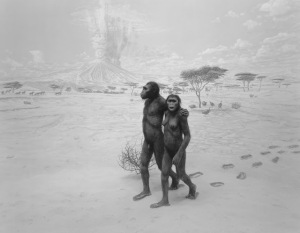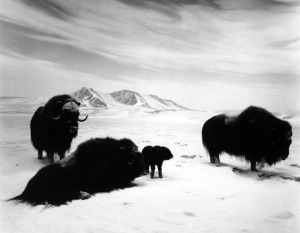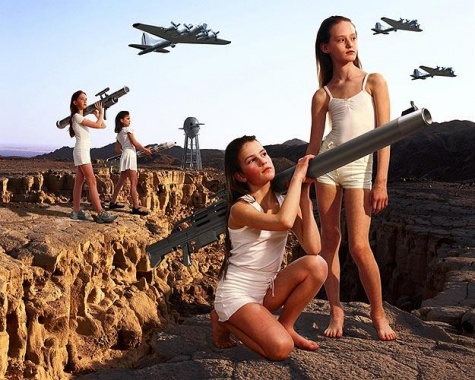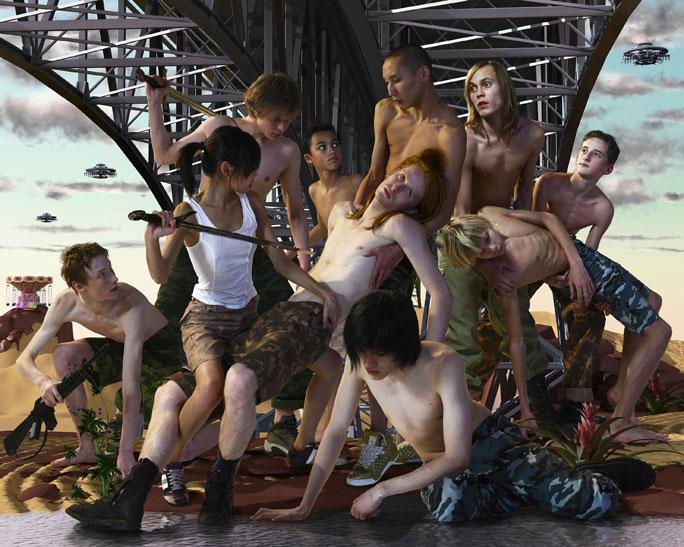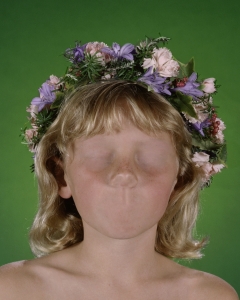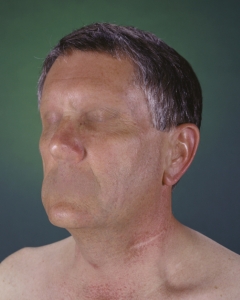1 – Paul Strand
“The unadorned building with its austere shapes takes up most of the space. With its repetition of lines and shapes, the image borders on the abstract. The giant rectangular holes do not reveal what goes on behind them; rather, it looks like the small figures could be swallowed up by them at any given moment. People are reduced to subordinate, indistinct puppets, their shadows nothing more than parallel lines in the overall pattern. In all, the image confronts us with the realization of how insignificant the individuals are in comparison to the huge J.P. Morgan Bank, a symbol of capitalism. Thus, while the first impression may be very factual, if we pause and ponder we can discover its implied personal message: a warning against greed and the power of money, and the loss of humanity that this may lead to.” – Quote from the internet. Read original here: http://rijksmuseumamsterdam.blogspot.com/2012/02/paul-strand-wall-street-1915-1915.html
————————————————
2 – Claude Monet (14 November 1840 – 5 December 1926) was a founder of French impressionist painting, and the most consistent
and prolific practitioner of the movement’s philosophy of expressing one’s perceptions before nature, especially as applied to pleinair
landscape painting. The term Impressionism is derived from the title of his painting Impression, Sunrise (Impression, soleil levant).
Painting Light:
When Monet painted the Rouen Cathedral series, he had long since been impressed with the way light imparts to a subject a distinctly
different character at different times of the day and the year, and as atmospheric conditions change. For Monet, the effects of light on a
subject became as important as the subject itself. His Series Paintings, in which he painted many views of the same subject under
different lighting conditions, are an attempt to illustrate the importance of light in our perception of a subject at a given time and place.
Robert Pelfrey, in Art and Mass Media (Kendall/Hunt, 1996), says:
By focusing on the same subject through a whole series of paintings, Monet was able to concentrate on recording visual sensations
themselves. The subjects did not change, but the visual sensations – due to changing conditions of light – changed constantly. (166)
Go to the following Wiki link for complete text and images of Rouen Cathedral:
http://en.wikipedia.org/wiki/Rouen_Cathedral_(Monet)
————————————————
3 – Andrew Gursky
Rhein II is a photograph made by German visual artist Andreas Gursky in 1999. In 2011, a print was auctioned for $4.3 million (then £2.7m), making it the most expensive photograph ever sold.
The photograph was produced as the second (and largest) of a set of six depicting the River Rhine. In the image, the Rhine flows horizontally across the field of view, between green fields, under an overcast sky.
Extraneous details such as dog-walkers and a factory building were removed by the artist via digital editing. Justifying this manipulation of the image, Gursky said “Paradoxically, this view of the Rhine cannot be obtained in situ, a fictitious construction was required to provide an accurate image of a modern river.” Gursky produced a very large chromogenic colour print of the photograph, mounted it onto acrylic glass, and then placed it in a frame. The image itself measures 73 by 143 inches (190 cm × 360 cm), while the frame measures 81 by 151 inches (210 cm × 380 cm).
————————————————
Michael Wolf
http://photomichaelwolf.com/#architecture-of-densitiy/5
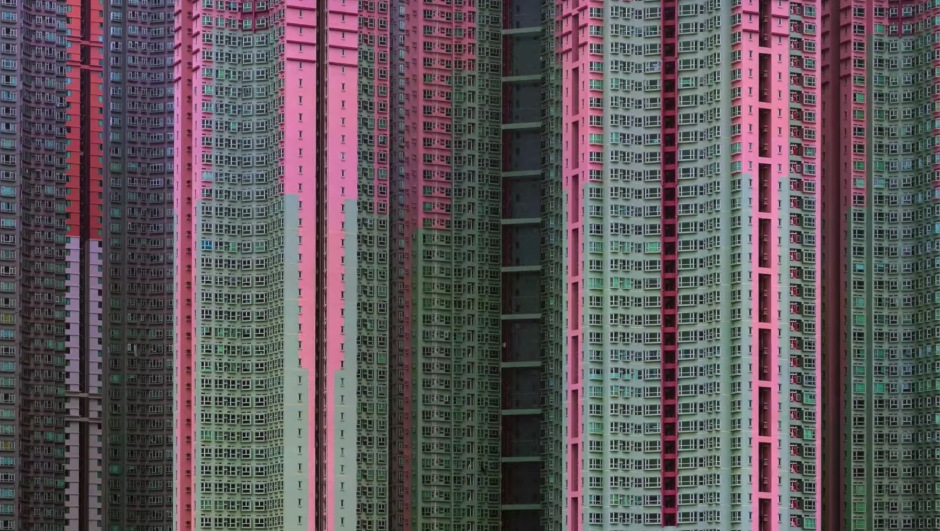
————————————————
video: https://art21.org/watch/new-york-close-up/lucas-blalocks-digital-toolkit/

————————————————
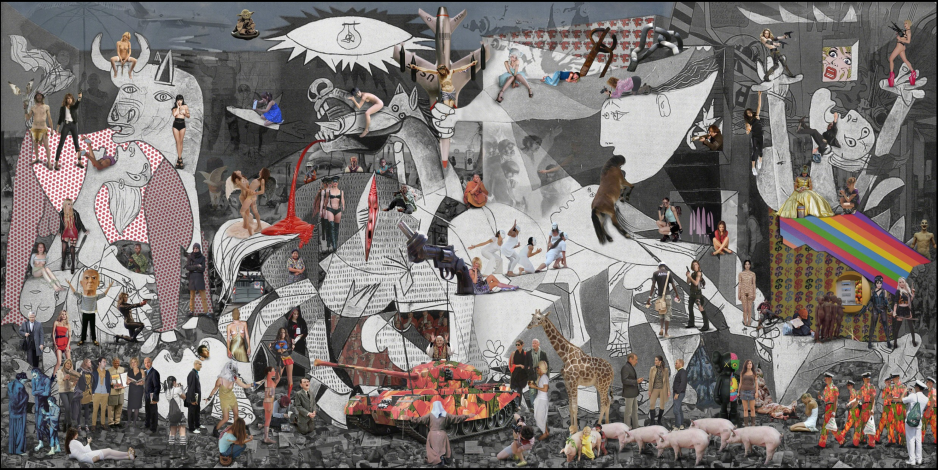
Lluis Barba’s epic, digitally manipulated images juxtapose iconic paintings from art history with photographs of modern tourists, celebrities, spectators of varied economic background, and appropriated advertising imagery. They critique the collusion between art, wealth, and glamor, particularly in the context of museum and gallery spaces. “I get elements of a reality out of context in order to put them in another reality,” he has said. “I use irony and implicit messages in the works such as the global integration of our society. I incorporate the bar code tattoo like a symbol of lost identity, alienation, and massive consumerism.”
————————————————
————————————————
Mark Dorf http://mdorf.com/nebulous/
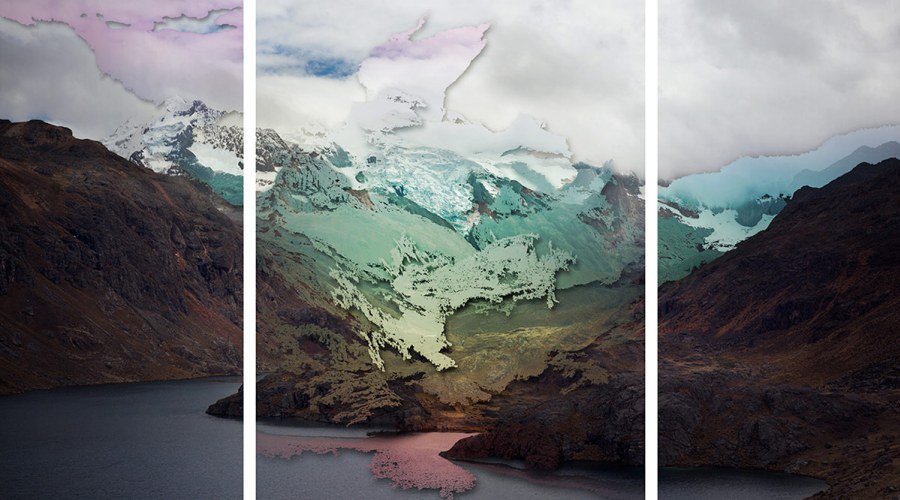
Mark Dorf is a New York based artist whose creative practice employs a mixture of photography, digital media, and sculpture. In his most recent work, Dorf explores society’s perceptions of and interactions with the digital domain, urban and architectural environments, and the “Natural Landscape”. With an interest in technology and science, he scrutinizes and examines the influence of the information age in order to understand our curious habitation of the 21st century world.
————————————————
David Hockney
————————————————
Chicago MCA : Elements of photography:
https://mcachicago.org/Exhibitions/2009/Elements-Of-Photography
————————————————
Florian Graf
————————————————
Li Wei
————————————————
Berndnaut Smilde
http://www.berndnaut.nl/works/nimbus/

————————————————
Giuseppe Loschiavo
http://www.giuseppeloschiavo.com/
————————————————
Hiroshi Sugimoto
http://www.sugimotohiroshi.com/
————————————————
AES+F
————————————————
Aziz+Cuchur
Anthony Aziz (b. Fitchburg, Massachusetts, USA) and Samuel Cucher (born 1958, Lima, Peru/grew up in Caracas, Venezuela) are visual artists working together as a collaborative team since meeting in graduate school in 1990 at the San Francisco Art Institute. They are pioneers in the field of digital imaging and post-photography with projects exhibited at numerous venues including the 1995 Venice Biennale, the LA County Museum of Art and the San Francisco Museum of Modern Art.
Aziz + Cucher have worked in many media including digital photography, video installation, sculpture, and textiles. They were among the first to use Adobe Photoshop in the context of fine art photography. The resulting series of images (1992–2002) can be seen as a commentary and reflection on the relationship between the human body and the technological forces that shape our society. In later projects (2003–2006), which grew to include video installation, their concerns shifted towards the way that our perception of nature and the landscape had been augmented and modified by technological mediation. Beginning in 2006, Aziz + Cucher embarked on the creation of a new body of work that looks at the landscape from a decidedly more historical and political perspective stemming from their own family connections to the middle east.
————————————————
Cindy Sherman
Cynthia “Cindy” Morris Sherman (born January 19, 1954) is an American photographer and film director, best known for herconceptual portraits. In 1995, she was the recipient of a MacArthur Fellowship. Through a number of different series of works, Sherman has sought to raise challenging and important questions about the role and representation of women in society, the media and the nature of the creation of art. Her photographs include some of the most expensive photographs ever sold. Sherman lives and works in New York.
————————————————
Marcel Dzama

https://art21.org/watch/extended-play/marcel-dzama-organizing-chaos-short/
Shown at work in his Brooklyn studio, Marcel Dzama discusses the evolution of his drawings, from his time growing up in his native Winnipeg, to his move to New York in 2004, to his more recent responses to U.S. politics and media. Fascinated by childhood monsters, like the Wolfman and Dracula, Dzama ruminates on his early drawings, often populated by three or four human, animal, or hybrid figures against isolated white backgrounds and inspired by Winnipeg’s snowy winters. While attending the University of Manitoba, the artist recalls a house fire that destroyed much of his early work and forced him to work on hotel stationary for his final thesis project.
As Dzama paints a new drawing of masked dancers in blue watercolor and root-beer syrup, he explains the formal and conceptual influences on his work, from Francis Picabia’s use of polka dots to the connection between the early twentieth century Dada artists’ condemnation of World War I and the artist’s own response to contemporary U.S. politics. Shown working on a pencil drawing inspired by American activist and survivor of the 2018 Parkland school shooting, Emma Gonzalez, the artist explains his practice as an exorcism of his daily news media diet.
Dzama also charts the impact of his move to New York on the work, expanding on how his white backgrounds became more densely populated with figures. Turning to dance magazine as a way to conceive of his drawings as still images of stage productions, Dzama began to organize the chaos of figures into stylized formations and moved away from animal figures, in favor of humans or human figures in animal costumes. Characterizing his drawings as having, “one foot in the subconscious,” the artist describes his practice of working at night, during a “witching hour,” when his most uncensored ideas can flow and anything feels possible.
————————————————
NARGIFSUS | ANIMATED SELF-PORTRAITS
Online GIF exhibition curated by Carla Gannis & Tina Sauerlaender
http://newhive.com/peertospace/nargifsus

————————————————
Here is another link with a lot of cool GIFs!
